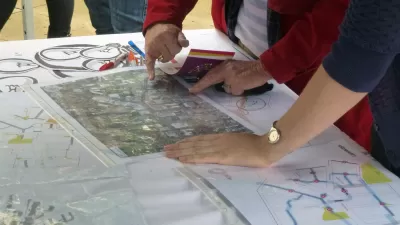Recent studies report a noted decrease in traffic congestion in the D.C. area. Robert McCartney credits two trends and asks how the area should spend additional transportation revenues that will be generated by recent tax increases.
"An unusual confluence of events has created a rare opportunity today for our region to do even more to unclog roads and improve the quality of life," says McCartney.
"Both Virginia and Maryland passed historic tax increases in the spring to raise additional billions of dollars for roads and transit. The new money is arriving just as two important, long-term trends improve the odds that the money could actually lead to appreciably less time wasted in backups."
"First, people are driving less, both in the Washington region and the rest of the nation," he explains. "Second, our area is seeing the benefits of so-called smart growth policies designed to concentrate development around mass transit, especially Metro stations, and generally encourage alternatives to driving."
McCartney looks at the balance of transportation investments that need to be demanded by the public, and some of the key battles that need to be resolved in order to build on recent gains.
"There’s money on the way and reason to believe that it can make a sizable dent in what’s often called the region’s biggest problem. Let’s not blow this chance."
UPDATE: For a critical response to McCartney's column, with suggestions for how to further reduce congestion without building new roads, see Richard Layman's post on the blog "Rebuilding Place in the Urban Space".
FULL STORY: Column: Washington area has a real chance to reduce traffic congestion

Trump Administration Could Effectively End Housing Voucher Program
Federal officials are eyeing major cuts to the Section 8 program that helps millions of low-income households pay rent.

Planetizen Federal Action Tracker
A weekly monitor of how Trump’s orders and actions are impacting planners and planning in America.

The 120 Year Old Tiny Home Villages That Sheltered San Francisco’s Earthquake Refugees
More than a century ago, San Francisco mobilized to house thousands of residents displaced by the 1906 earthquake. Could their strategy offer a model for the present?

HSR Reaches Key Settlement in Northern California City
The state’s high-speed rail authority reached an agreement with Millbrae, a key city on the train’s proposed route to San Francisco.

Washington State Legislature Passes Parking Reform Bill
A bill that would limit parking requirements for new developments is headed to the governor’s desk.

Missouri Law Would Ban Protections for Housing Voucher Users
A state law seeks to overturn source-of-income discrimination bans passed by several Missouri cities.
Urban Design for Planners 1: Software Tools
This six-course series explores essential urban design concepts using open source software and equips planners with the tools they need to participate fully in the urban design process.
Planning for Universal Design
Learn the tools for implementing Universal Design in planning regulations.
Ada County Highway District
Clanton & Associates, Inc.
Jessamine County Fiscal Court
Institute for Housing and Urban Development Studies (IHS)
City of Grandview
Harvard GSD Executive Education
Toledo-Lucas County Plan Commissions
Salt Lake City
NYU Wagner Graduate School of Public Service




























